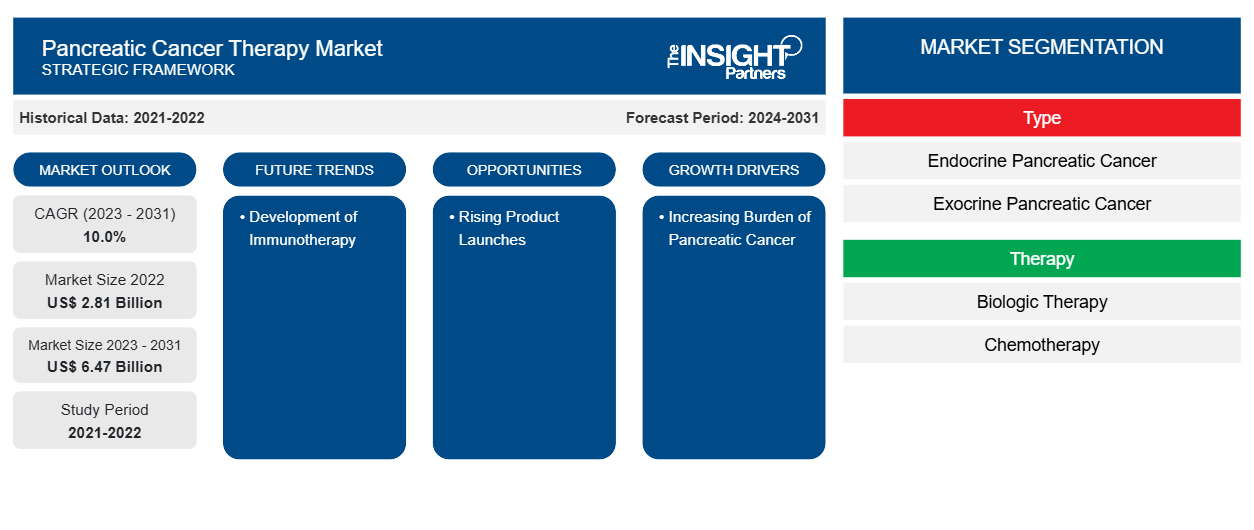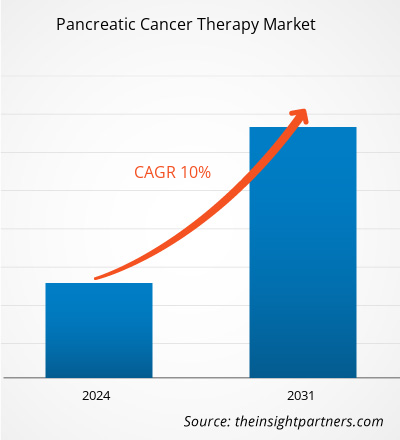The Pancreatic Cancer Therapy Market size was estimated to be US$ 2.81 billion in 2022 and US$ XX million in 2023 and is expected to reach US$ 6.47 billion by 2031; it is estimated to record a CAGR of 10.0% till 2031. The rapid adoption of combination therapy is likely to remain key Pancreatic Cancer Therapy Market trend.
Pancreatic Cancer Therapy Market Analysis
The increasing prevalence of pancreatic cancer, advancement in cancer treatment technologies, use of a combination of multiple treatments, insurance coverage of pancreatic therapy, and increasing support from the government for the treatment of cancer is fueling the growth of the pancreatic cancer therapy market. In addition, increasing product launches and investment in R&D for the development of cancer diagnostics and treatment is fueling the growth of the market.
Pancreatic Cancer Therapy Market Overview
India is among the countries that are emerging in terms of healthcare infrastructure and also in terms of diagnosis for several diseases. The prevalence of pancreatic cancer is rising and the cancer is initially undetected due to which the cancer spreads rapidly till it is detected. Due to rapid advancement in medical science and technology, cancer treatment in India is rapidly developing. There are many skilled oncologists in India who have treated pancreatic cancer due to which patients from various countries are coming to India for treatment. In, addition, much research is going on in the country for the development of various therapies for the treatment of pancreatic cancers. Thus increasing R&D activities for cancer treatment, increasing medical tourism due to the presence of a skilled workforce, and rapid advancement in healthcare institutions is fuelling the growth of the pancreatic cancer therapy market in India.
Customize This Report To Suit Your Requirement
You will get customization on any report - free of charge - including parts of this report, or country-level analysis, Excel Data pack, as well as avail great offers and discounts for start-ups & universities
Pancreatic Cancer Therapy Market: Strategic Insights

-
Get Top Key Market Trends of this report.This FREE sample will include data analysis, ranging from market trends to estimates and forecasts.
Pancreatic Cancer Therapy Market Drivers and Opportunities
Increasing Burden of Pancreatic Cancer
Pancreatic cancer is one of the aggressive cancers that originates in the in the tissues of pancreas and rapidly spreads to the nearby organs. Despite rapid developments in medical technology and improvements in survival rates of other cancers, pancreatic cancer is still a highly lethal cancer with a low 5-year survival rate and difficulty in early detection. As per the World Cancer Research Fund International, pancreatic cancer is the 12th most common cancer worldwide. As per the same source, in 2020, ~495,000 new cases of pancreatic cancer were diagnosed globally. There is a steady increase in incidence and mortality rate due to pancreatic cancer in people aged above 40 years. According to the estimated by American Cancer Society, about 66,440 people in the US will be diagnosed with pancreatic cancer in 2024 and ~51,750 people in the US will die due to pancreatic cancer. As per American Society of Clinical Oncology, in 2023, ~64,050 people in the US were diagnosed with pancreatic cancer. Thus, the increasing prevalence of pancreatic cancer is fuelling the growth of the pancreatic cancer therapy market.
Development of Immunotherapy– An Opportunity for Pancreatic Cancer Therapy Market
There are various rapid advancements in the therapy type used for the treatment of pancreatic cancer. Immunotherapy is a new therapy type which is used to treat other cancer types such as lymphoma, breast cancer, and leukemia. There are studies going on to check the efficacy of immunotherapy, especially T-cells in the treatment of pancreatic cancer. Pancreatic Cancer has shown the presence of tumor-infiltrating lymphocytes (TILs) due to which the T-cell therapy has demonstrated positive result in the treatment of solid tumors such as pancreatic cancer. Thus, ongoing research for the use of immunotherapy for the treatment of pancreatic cancer creates growth opportunities for the pancreatic cancer therapy market.
Pancreatic Cancer Therapy Market Report Segmentation Analysis
Key segments that contributed to the derivation of the Pancreatic Cancer Therapy Market analysis are solutions, mode of delivery, application, and end user.
- Based on type, the Pancreatic Cancer Therapy Market is segmented into endocrine pancreatic cancer and exocrine pancreatic cancer. The exocrine pancreatic cancer segment held a larger market share in 2023.
- By therapy, the Pancreatic Cancer Therapy Market is segmented into biologic therapy, chemotherapy, and others. The biologic therapy segment held the largest market share in 2023.
Pancreatic Cancer Therapy Market Share Analysis by Geography
The geographic scope of the Pancreatic Cancer Therapy Market report is mainly divided into five regions: North America, Asia Pacific, Europe, Middle East & Africa, and South & Central America.
North America has dominated the Pancreatic Cancer Therapy Market. The demand for the market in the region is anticipated to witness growth at a significant rate during the forecast period owing to various factors such as, rising prevalence of pancreatic cancer, a growing aging population in the region, and the presence of key players. Furthermore, the US government is opting for creating awareness about pancreatic cancer and extensive investment in R&D in the field of cancer treatment is likely to influence the pancreatic cancer therapy market. Also, improved insurance coverage for the treatment of cancer and awareness about early detection of pancreatic cancer is fueling the growth of the pancreatic cancer therapy market.
Pancreatic Cancer Therapy Market Regional InsightsThe regional trends and factors influencing the Pancreatic Cancer Therapy Market throughout the forecast period have been thoroughly explained by the analysts at The Insight Partners. This section also discusses Pancreatic Cancer Therapy Market segments and geography across North America, Europe, Asia Pacific, Middle East and Africa, and South and Central America.
Pancreatic Cancer Therapy Market Report Scope
| Report Attribute | Details |
|---|---|
| Market size in 2022 | US$ 2.81 Billion |
| Market Size by 2031 | US$ 6.47 Billion |
| Global CAGR (2023 - 2031) | 10.0% |
| Historical Data | 2021-2022 |
| Forecast period | 2024-2031 |
| Segments Covered |
By Type
|
| Regions and Countries Covered |
North America
|
| Market leaders and key company profiles |
|
Pancreatic Cancer Therapy Market Players Density: Understanding Its Impact on Business Dynamics
The Pancreatic Cancer Therapy Market is growing rapidly, driven by increasing end-user demand due to factors such as evolving consumer preferences, technological advancements, and greater awareness of the product's benefits. As demand rises, businesses are expanding their offerings, innovating to meet consumer needs, and capitalizing on emerging trends, which further fuels market growth.

- Get the Pancreatic Cancer Therapy Market top key players overview
Pancreatic Cancer Therapy Market News and Recent Developments
The Pancreatic Cancer Therapy Market is evaluated by gathering qualitative and quantitative data post primary and secondary research, which includes important corporate publications, association data, and databases. The following is a list of developments in the market for neurointerventional devices and strategies:
- Focal Medical received the US Food and Drug Administration (FDA) clearance for its investigational new drug application for ACT-IOP-003. ACT-IOP-003 is a pancreatic cancer drug in Phase 1b of clinical trial. ACT-IOP-003 is an implantable iontophoretic product that deliver high levels of gemcitabine directly to the pancreas. (Source: Verdict Media Limited, Press Release, 2024)
- The FDA approved irinotecan liposome (Onivyde) with oxaliplatin, fluorouracil, and leucovorin, for the first-line treatment of metastatic pancreatic adenocarcinoma. The drug Onivyde is manufactured by Ipsen Biopharmaceuticals Inc. (Source: FDA, Press Release, 2024)
Pancreatic Cancer Therapy Market Report Coverage and Deliverables
The “Pancreatic Cancer Therapy Market Size and Forecast (2023–2031)” report provides a detailed analysis of the market covering below areas:
- Market size and forecast at global, regional, and country levels for all the key market segments covered under the scope
- Market dynamics such as drivers, restraints, and key opportunities
- Key future trends
- Detailed PEST/Porter’s Five Forces and SWOT analysis
- Global and regional market analysis covering key market trends, major players, regulations, and recent market developments
- Industry landscape and competition analysis covering market concentration, heat map analysis, prominent players, and recent developments
- Detailed company profiles
- Historical Analysis (2 Years), Base Year, Forecast (7 Years) with CAGR
- PEST and SWOT Analysis
- Market Size Value / Volume - Global, Regional, Country
- Industry and Competitive Landscape
- Excel Dataset
Recent Reports
Related Reports
Testimonials
Reason to Buy
- Informed Decision-Making
- Understanding Market Dynamics
- Competitive Analysis
- Identifying Emerging Markets
- Customer Insights
- Market Forecasts
- Risk Mitigation
- Boosting Operational Efficiency
- Strategic Planning
- Investment Justification
- Tracking Industry Innovations
- Aligning with Regulatory Trends





















 Get Free Sample For
Get Free Sample For